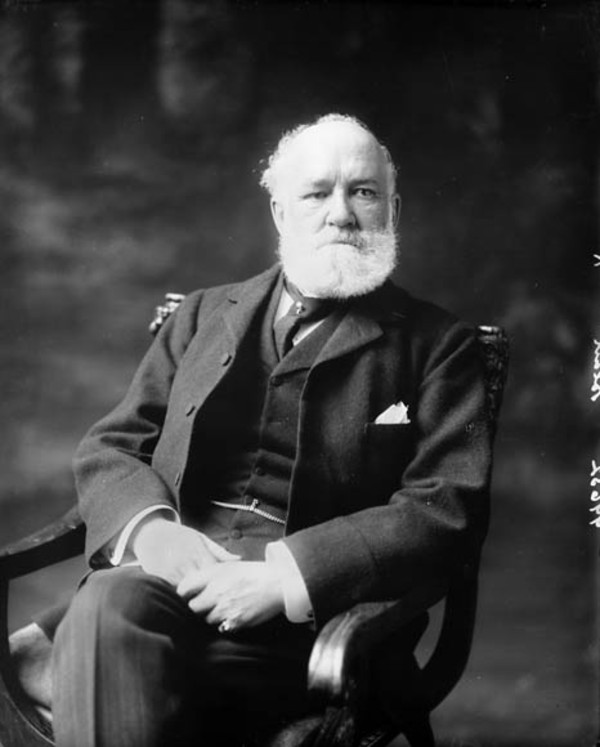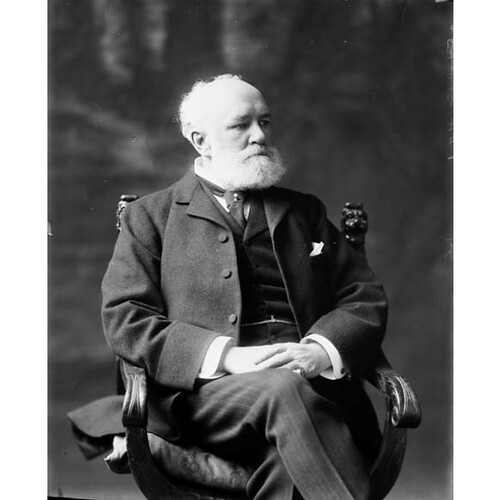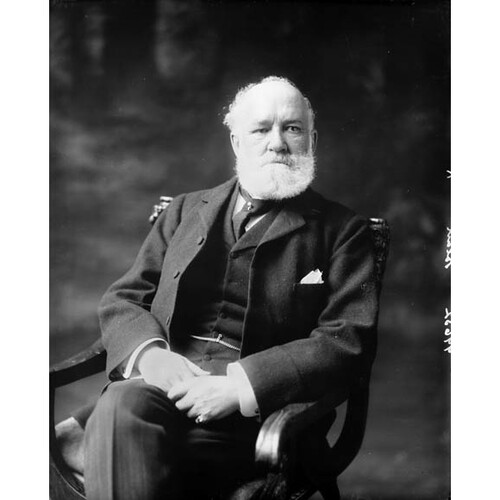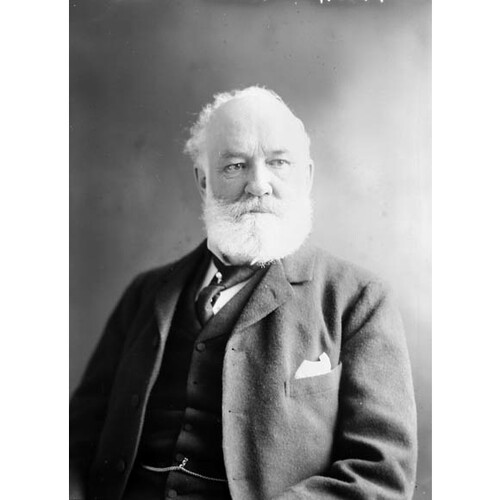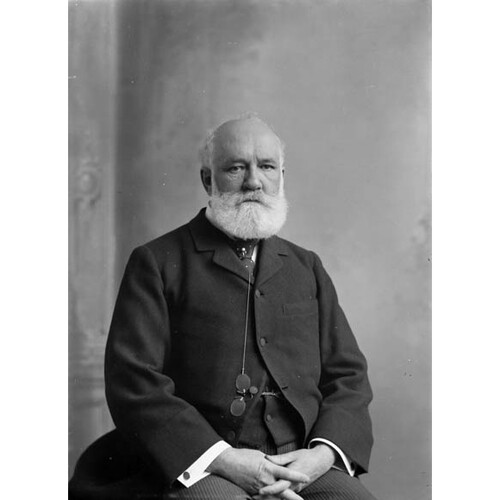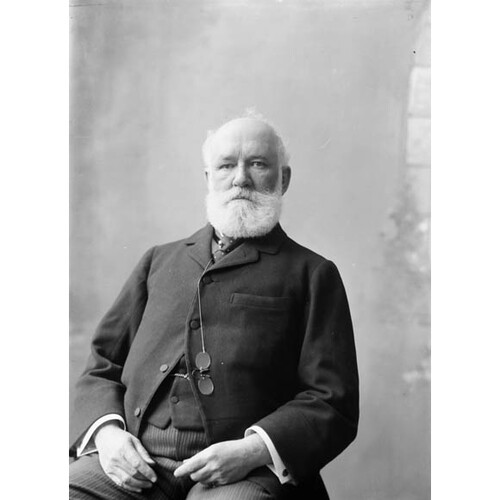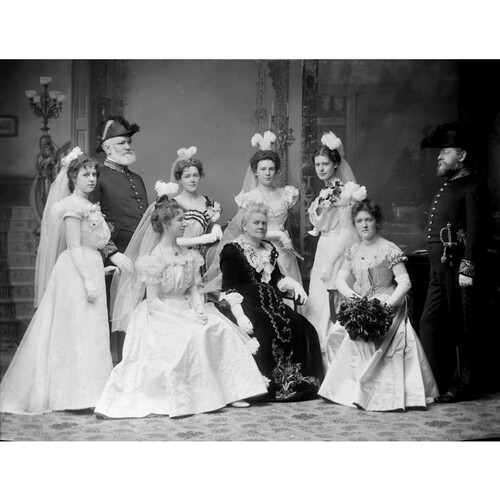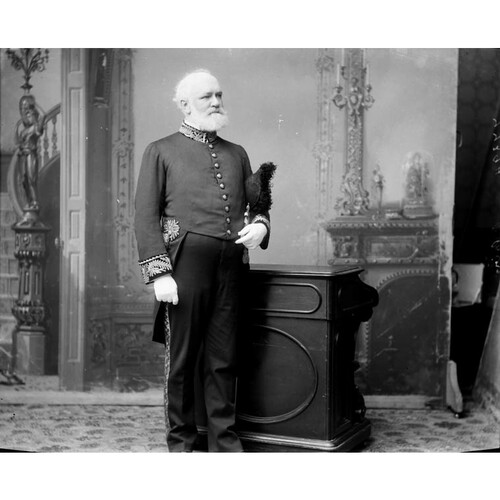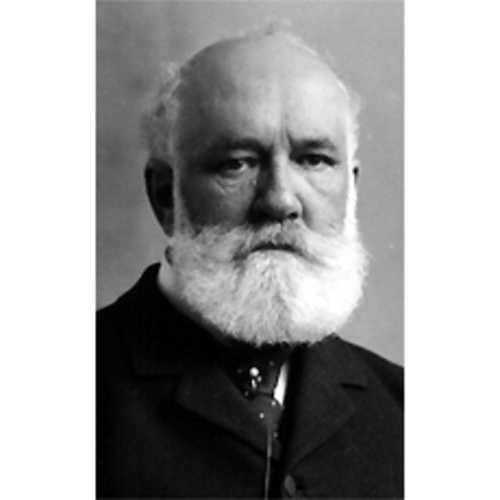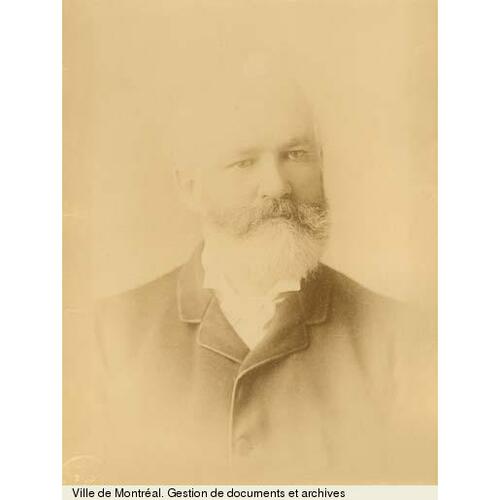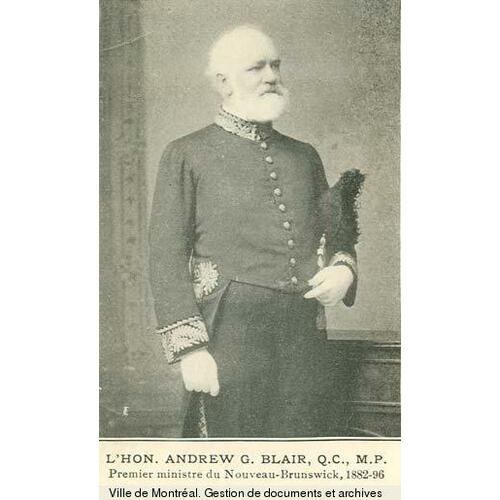BLAIR, ANDREW GEORGE, lawyer and politician; b. 7 March 1844 in Fredericton, son of Andrew Blair and Mary Ann Segee; m. there 31 Oct. 1866 Annie Elizabeth Thompson, and of their ten children two sons and five daughters survived him; d. there 25 Jan. 1907.
Andrew Blair’s father, a native of Halifax and about 57 years of age when Andrew was born, was referred to in the 1851 census as a carpenter, and elsewhere variously as surveyor, road commissioner, and contractor; he died when his son was 15. The chief male influence on Andrew’s early youth was his mother’s youngest brother, George N. Segee. After education in the Fredericton Collegiate School, Andrew entered his uncle’s law office at age 14, and on Segee’s death in 1863 completed his legal studies under John Campbell Allen*. Admitted as an attorney in 1865 and called to the bar in April 1866, he entered into partnership in 1867 with George Frederick Gregory.
By the age of 20 Blair had become head of the household with responsibility for his mother and two younger sisters. He was married two years later. His parents were Presbyterian, as he himself was in his later years, but as a young man he was associated with the Methodist church to which his wife belonged. His Scottish and non-conformist background, and early success in making his way in the world, led him to be self-reliant and independent in his judgements and to question the respect for colonial tradition that prevailed among officials in the downtown Fredericton neighbourhood where he grew up.
After running unsuccessfully in the provincial elections of 1870 and 1874, Blair was elected to the House of Assembly for York County at the head of the poll in 1878. The other successful candidates were Premier John James Fraser*, George Johnson Colter, and Frederick Pemberton Thompson. In federal politics Blair supported Sir John A. Macdonald*’s Liberal Conservatives, as did Fraser and Cotter; Thompson, his wife’s cousin, was a Liberal. Federal party labels counted for little in the assembly, where members chose government or opposition on the basis of constituency interests or personal concerns. Blair quickly became the centre of an opposition faction that by 1881 saw itself as the core of an alternative government. Constituency interests took precedence on 23 March when a vote was taken on the location of the capital, the parliament house in Fredericton having burned the previous month. Blair and nine members of the opposition joined Fraser and nine government members to defeat Saint John’s aspirations and carry the retention of Fredericton by a margin of 20 to 18.
Three decades later an Ottawa observer was to describe Blair as “a democrat to the hilt,” but in this debate his arguments were thoroughly Burkean: “God forbid that a question like this should be bandied about by the passions of the mob,” he burst out on one occasion. At most times Blair used the vocabulary of liberal radicals of the era. In a resolution, really an election manifesto, that he gave notice of moving on 19 Feb. 1881, he advocated “the abolition of the Legislative Council; a reduction in the number of members in the Executive, the discontinuance after the term of office of the present Lieutenant Governor, of the payment of the salary of a private secretary of the Lieutenant Governor, and the maintenance at the public expense of the Government House as an official residence; the adoption of a more practical and economical management in educational matters and the making of such changes in the Governmental, Legislative and Departmental machinery of the Province as will ensure a substantial reduction in the cost thereof.”
In the campaigns for the provincial and federal elections in June 1882, the “opposition party” was favoured by the Liberal press, notably William Elder*’s Daily Telegraph in Saint John, John Valentine Ellis*’s Saint John Globe, and two vigorous new newspapers, the Moncton Daily Transcript and the Fredericton Evening Herald. While Blair himself moved cautiously into the Liberal camp at this time, he took care not to alienate Liberal Conservative supporters such as the valued James Mitchell* of Charlotte County. In York, he and Thompson were re-elected, placing third and fourth in the voting. Voters in Saint John, disaffected by the downturn in their economic and political fortunes following the building of the Intercolonial Railway, elected candidates opposed to the government. In by-elections held before the meeting of the new assembly in February, Blair launched a new style of province-wide campaigning that marked the transition of the opposition from a coalition of constituency politicians into a genuine provincial party.
The balance of power was held by independents and a few waverers. Blair, whose core of committed supporters was smaller than Premier Daniel Lionel Hanington’s, proved more adept at flattery and appeals to greed and ambition. In the vote to choose the speaker, two of Blair’s regular supporters abstained and a third voted for the government candidate, James Edward Lynott. Four days later, on 26 Feb. 1883, with Lynott in the chair and thereby prevented from voting, Blair introduced a want of confidence motion which, with two government members joining him, was carried 22 to 18; one of the defectors, Gaius Samuel Turner, would be made a member of Blair’s Executive Council. Joseph Edmund Collins*, writing in 1884 in Canada under . . . Lord Lorne, implied that “loose fish” had been bribed with money, but this insinuation seems little more than smoking-room gossip.
Blair became attorney general and premier. Like most attorneys general of that era, he continued to carry on a private legal practice, necessary in his case to meet his family responsibilities; he would later be described by Chief Justice William Henry Tuck* as “undoubtedly the most skilful cross-examiner” at the provincial bar. The other portfolio holders in the new government, announced on 3 March, were: William Elder, provincial secretary; Thomas Francis Gillespie, president of the Executive Council; Patrick George Ryan, chief commissioner of public works; James Mitchell, surveyor general; and Robert John Ritchie, solicitor general. Overall three of the nine members of the executive were supporters of the Macdonald Conservatives, as were several backbenchers.
Safely in office, Blair showed himself to be a master of hard-headed practicality. In an adroit display of political legerdemain he made the opposition ineffective, persuading several members to cross the floor. The limited political and financial resources available were carefully husbanded to balance competing constituency interests and appease personal and sectarian rivalries, with some kept available to serve the general interests of the province. Blair was the mainspring: “What a worker he was in those days! He expected every official to perform his duty faithfully and well and it was done as a pleasure,” a colleague later recalled. Usually tactful and sociable, he could turn into a ruthless autocrat. No other premier in the province’s history was to arouse such bitter and sustained personal hostility.
His boldness in overcoming obstacles can be seen in his success in having a bridge three-quarters of a mile long built across the Saint John River to link Fredericton to the villages growing up around the railway line and factories of Alexander Gibson*, his most prominent supporter. He went ahead in defiance of the federal authorities, who maintained that the province had no authority to pass legislation for the construction of a bridge over a navigable river. His calling of the tender early in 1884 before the legislature had approved the expenditure led to several critical votes there. He also took a chance by entrusting the design to Alfred Haines, an engineer who had had no formal training, and by authorizing the use of cribwork piers and a wooden superstructure in place of much more expensive stone and steel. Dubbed “Blair’s Paper Bridge” by critics, the structure stood for 20 years before a fire destroyed two spans in 1905. Although as construction proceeded in 1884–85 Blair made his peace with the federal government, he reserved the right, “if occasion arises,” to dispose of the legal or constitutional question in the courts. Another issue of provincial rights of concern to Blair was settled in 1885; in December the Judicial Committee of the Privy Council announced its decision, on the McCarthy Act reference, that the power to grant liquor licences vested in the provinces as well as the dominion.
In 1882 the Fredericton Capital had portrayed Blair as a radical “ready to sacrifice the old institutions of the country.” But all he sacrificed during his first term was the comfort of the lieutenant governor, by taking away the salary of his private secretary and by so reducing the grant for the upkeep of Government House that Sir Samuel Leonard Tilley*, appointed on 11 Nov. 1885, was forced to arrange his own accommodation. Small changes were made in the elections law in 1886, including the grant of the municipal franchise to widows and unmarried females meeting the property qualification. The only other significant reform involved the funding of the provincial debt.
Blair blamed the Legislative Council for his government’s poor record. It is true that the upper house had defeated a number of bills, but there was also some justification for his opponents’ taunts that he had made no serious effort to carry out the central plank in his reform agenda, the abolition of the council. When, in March 1886, that body produced a cleverly worded financial report advocating much of Blair’s 1881 program, the government was faced with the prospect of either voting against its own program or admitting that it had been incompetent. Blair extricated himself by appointing two new members to the council in order to pass the supply bill, and then hastily called an election for 26 April.
The moment could not have been more favourable. The opposition was completely unprepared and he had a popular issue, the attempt by council to usurp powers over revenue that, in his words, “belonged only to members of the Assembly.” Of the 41 members of the new assembly, 30 supported the government; there were two independents. By holding the election at a time when there was no federal election imminent, Blair had avoided offending the sensibilities of the Liberal Conservatives in his party. Later he also took pains to dissociate himself from the reservoir of anti-confederate sentiment in New Brunswick. At the organizational meeting of the New Brunswick Liberal Association on 24 June 1886 a motion was made to congratulate William Stevens Fielding* of Nova Scotia on his recent electoral victory on a secession platform. Though it was ruled out of order, Blair took the precaution of releasing the text of his speech, in which he stated that “the repeal of the union was not yet a factor in Dominion politics, and if it ever became one those who desired to bring it about would not be the Liberal party, but the repeal party.”
In October 1887, at the invitation of Honoré Mercier*, Blair and David McLellan, the provincial secretary, attended the inter-provincial conference at Quebec, chaired by Oliver Mowat of Ontario. There they opposed a Manitoba scheme that would have weakened Ottawa’s control over railway policy, but supported the proposals for strengthening provincial rights and of course were not averse to the conference’s endorsement of increased subsidies for the provinces. In moving the Quebec resolutions in the assembly in March 1888, Blair took care to stress that in its administration of affairs his government “knows neither liberal nor conservative” and “is composed of gentlemen some of whom are in sympathy with the Dominion government.” When asked later why the resolution concerning unrestricted reciprocity had not been submitted to the house, he replied that it had not been “passed by the conference as a conference.” He noted, however, “that he was just as strong for unrestricted reciprocity now as he was when he voted for that resolution,” thus firmly identifying himself, though not his government, with the federal Liberals.
Meantime, Ottawa was in the process of bestowing a bonus in the form of the “Short Line” across the state of Maine from Montreal to the Maritime ports. Opened in 1889, and placed in the hands of the Canadian Pacific Railway, this line made it possible for Saint John to compete with Portland, Maine, as the winter port for Montreal. While he welcomed federal largesse, Blair was cautious in committing provincial resources to the building of railways. His refusal to follow the usual practice of promising assistance to all and sundry had led in 1888 to a bitter feud with a supporter, Dr Marcus Chappell Atkinson of Carleton County, whom he angrily accused of breaching party discipline. A few months earlier he had offended his own law partner, who accused him of losing a case by failing to have the charge drawn up properly. A public correspondence in the newspapers ended in the breakup of their two-decade-long partnership, with Gregory asserting that “Mr. Blair does not regard candour as at all essential for a public man.” James H. Crocket, a supporter of Gregory and the federal Liberals, then launched a vendetta against Blair in the Fredericton Daily Gleaner.
On New Year’s Eve 1889 Blair suddenly called an election, ostensibly because the assembly was no longer representative, an act that year having removed the property qualifications for both voters and candidates. In fact, a number of his supporters had gone over to the opposition, upset by his public quarrels and his failure to satisfy expectations, particularly in Saint John and in the north of the province, where his crown lands policy was unpopular. Of the 27 seats contested, the government won only eight. But there were also 14 uncontested seats; of these his party held 13, just enough to deny the opposition a majority. Immediately, Blair went “floundering through the drifts.” to the Miramichi valley, where, in “the Northumberland deal,” he arranged a coalition with the four independent opposition members elected for that county. One of them, Lemuel John Tweedie*, entered the government as surveyor general, with responsibility for crown lands. Two others, it was alleged, received satisfaction for a debt that was in dispute. The fourth, lumberman John Percival Burchill*, a former supporter, was induced to return to the fold by the promise of major changes in the regulations governing crown lands.
As a result of the animosities of Gregory, Crocket, and Atkinson, post-election protests were pursued with more than usual virulence. In York, Gregory and another unsuccessful candidate brought suit against Blair and his fellow members alleging 1,123 specific acts of corrupt practice. On 1 October, with the issue still in the courts and unlikely to be resolved, the members resigned, bringing on a by-election in which Gregory was again defeated. The previous April Dr Atkinson had accused Blair in the legislature of having received “a large sum of money” as a campaign contribution from James D. Leary in return for the promise of a contract for the construction of dock and harbour facilities in Saint John. Blair demanded an immediate investigation into the matter. The committee of inquiry divided on party lines, with the majority regretting in its report that “such a groundless and malicious charge should have been made.” The minority felt that the investigation had “not been as thorough and as searching as . . . it should have been.”
On the positive side, the legislature was finally responsive to Blair’s wish to abolish the Legislative Council. Throughout the eighties the councillors had resisted reform or abolition and in 1888, in their chosen role as the effective opposition to the government, they had held up a number of bills and refused to pass the Quebec resolutions. The following year, however, Robert Young, whom Blair had accused of leading the opposition, agreed to support abolition, and in 1891, when appointing seven new councillors, Blair had each of them sign a formal pledge to that effect. They kept their word, apart from adding a provision that the abolition act would not come into operation until the closing of the first session of the legislature in 1894, “or until the present House of Assembly ceases to exist by dissolution.”
The end came on 28 Sept. 1892 when Blair called an election in an effort to prevent the breakup of the Liberal party in Saint John, where Charles Nelson Skinner, mp, and several other Liberals had become Conservatives. In the voting on 22 October his party gained support in most parts of the province, but Saint John’s six seats were won by the opposition and in York Blair suffered personal defeat; he was second last at the poll, receiving 353 fewer votes than the lowest of the opposition candidates elected. Within a few months he had moved his family and transferred his law practice to Saint John where, in 1894, his American-trained son, also named Andrew George, joined him as a partner. Meantime, in November, he had won a by-election in Queens County, where Thomas Hetherington had resigned to make way for him.
The campaign in York had brought to the fore an evangelical Protestant, Herman Henry Pitts, editor of the influential weekly the Reporter and Fredericton Advertiser, who combined an appeal for social reform and political purity with opposition to the cultural pluralism that Blair accepted as a necessary part of the political fabric of the province. The effectiveness of Pitts’s attack on the premier, whom he viewed as the champion of “Rum and Rome,” lay in his linking the Social Gospel to the fear that, by encouraging Acadian and Roman Catholic aspirations, Blair was destroying the Protestant character of New Brunswick.
“In all the big questions,” Joseph-Israël Tarte was to say, “questions involving problems of creed and race, Mr. Blair always proved himself . . . a man of fine intuitions, broad sympathies and lofty intellect.” He had long enjoyed excellent relations with the small Roman Catholic minority in York County, and after his break with Gregory had chosen Jeremiah Hayes Barry, a Catholic, as his law partner. But his party was predominantly Protestant until 1889 when, courting a backlash, he remade its image by recognizing the growing strength of the Roman Catholic and French-speaking elements in the population.
In May 1889 Blair appointed the solicitor general, Robert J. Ritchie, also a Catholic, as the new police magistrate of Saint John, a position which had been given prestige that spring in an act amalgamating the city with nearby Portland. In doing so, he passed over a scion of the old loyalist ascendancy, Benjamin Lester Peters, who had been common clerk for 25 years and police magistrate since 1882. Two Saint John Liberals, Alfred Augustus Stockton and Silas Alward, chose this occasion to break with him. After they led the opposition to victory in the Saint John constituencies in 1890, Blair was to charge that they had “performed the striking feat of riding into the House on a Protestant horse.”
Also in 1889 Blair appointed Olivier-J. Le Blanc to the Executive Council. Writing to Lieutenant-Governor Tilley in August, he explained: “The French people comprise so large a portion now of our own population . . . that we have thought we would only be meeting their reasonable expectations, if we should ask a representative man among them to take a seat with us.” Two years later Le Blanc became a member of the Legislative Council – on 10 April, the very day on which the bill for its abolition was introduced in the upper house. Blair had attended the first Acadian convention at Memramcook in 1881 [see François-Xavier Cormier] and had later drawn individual Acadian mhas into his patronage network, but before the promotion of Le Blanc the only significant measures his administration had taken in favour of the Acadians were the replacement in 1884 of the preparatory department in the Fredericton Normal School by a French department presided over by Alphée Belliveau*, the authorization of one or two textbooks for use in French-English schools, and some additional use of French in debates in the assembly.
Of much more immediate political import than these modest measures were the decisions of two Bathurst school boards to incorporate local convent schools into the public system established by the Common Schools Act of 1871 [see George Edwin King]. When Protestant ratepayers complained, the government, in its role as the Board of Education, saw no need to intervene, both government and opposition members being willing to evade the issue. In September 1891, however, during a by-election in Kent County, Peter John Veniot*, the young nationalist editor of the Bathurst weekly Courrier des Provinces maritimes, issued a pamphlet in French which equated support for the government with preservation of the Acadians’ language and religion. In 1892 Pitts showered York County with a translated version and accused Blair of complicity to subvert the non-sectarian character of the common schools. The appointment, on the eve of the election that year, of Ambroise-D. Richard of Westmorland as solicitor general to succeed William Pugsley* may have served to confirm the uneasiness of the voters of York. Blair won only two parishes. The appointment brought no immediate political advantage in Westmorland either, for the predominantly French parishes voted on party lines without favouring the Acadian candidates.
Blair maintained that the operation of the Bathurst schools was consistent with the educational compromise constructed in 1875 by the “very framers of the law, those who . . . were responsible for its non-sectarian character.” After winning a formal vote of confidence on a straight party vote in April 1893, he appointed J. J. Fraser, one of the architects of the compromise and now a judge, to conduct an investigation; Fraser’s report in 1894 rejected charges of clerical interference in the Bathurst schools. A legal challenge by the Bathurst Orange lodge had the effect of taking the issue out of the editorial arena throughout 1895; the suit was heard before Frederick Eustache Barker, who would dismiss the case early in 1896.
Redistribution in March 1895 added three seats to the legislature in predominantly Acadian counties. In the general election the following October the opposition won only nine seats; Blair and his supporters had 37, seven of them Acadian constituencies. During the campaign the opposition had made an attempt to organize the electorate on federal party lines. Blair countered by having his supporters focus on the provincial party manifesto, by attempting to make peace with the Orange lodges, and by striking deals that allowed a few prominent opposition figures to be elected. In Saint John, for example, the government agreed not to contest the four city seats in return for the withdrawal of the opposition from contention in the county, where one of Blair’s candidates was a prominent Orangeman.
While Blair was prepared at times to take firm action, as in the case of the Acadians, he was essentially a political trimmer. In 1895 a Liberal newspaper referred to him as “an old fogey and an old tory” because of his stand against women’s suffrage. Ten years earlier he had introduced a bill to grant the provincial franchise to single women and widows owning property; it failed to pass the Legislative Council. Although the municipal franchise was extended to unmarried and widowed women in 1886, the government made no further attempt to promote provincial female suffrage, probably because of firm opposition in some parts of the province. In 1889 Blair reproved Stockton and Henry Robert Emmerson* for their emotionalism and sentimentalism in favouring votes for women. In a debate that year, he declared rhetorically that “the Creator designed woman . . . for the duties of a higher and nobler sphere.” When Stockton interrupted, “Put her in a cage like a canary,” he continued, “I would sooner see her in a cage than in a polling booth – and a cage is the proper place for a canary.” Legislation in 1893 permitting one woman member on each board of school trustees was his only other concession.
Finding the money for the normal work of government was a constant struggle. When he first entered office, Blair gave himself some latitude by increasing stumpage fees on timber cut on crown lands; in the late 1880s territorial revenue provided 20 per cent of the province’s income. This increase did not seriously affect Alexander Gibson and his fellow lumber barons in the south, who depended mainly on lands held in freehold. In the north, however, lumbermen became increasingly disaffected until finally Blair was forced to concede a reduction of 20 per cent as part of the 1890 “Northumberland deal.” Lacking acceptable alternatives, the government increasingly relied on borrowing to meet its needs.
In general the crown lands policies of the Blair government favoured the big lumbermen. Leases were made renewable for 10 years in 1883 and for 25 years in 1892. Secure tenure allowed long-term planning and encouraged the building of facilities for moving timber efficiently. The 1892 reforms, which were recommended by a special commission to inquire into the industry, also included the employment of forest rangers on a full-time basis. In the related area of game management, a major revision of the system for leasing salmon rivers was introduced in 1884 and a game act in 1893 which consolidated earlier legislation and set out an administrative structure for game protection; the wilderness was becoming an asset of value for attracting tourists as well as for its traditional products.
Blair’s overwhelming victory in the 1895 election demonstrated his mastery of the provincial scene, but his status in the federal Liberal party remained equivocal. He had been appointed a vice-chairman of its 1893 convention but had kept silent on the subjects under discussion and over the next two years had not committed himself on federal matters. He thus avoided offending both his Conservative supporters at home and the ruling Conservatives in Ottawa; indeed, his apparent bipartisanship led early in 1896 to suspicions that he was attempting to profit from the internal party quarrels plaguing Prime Minister Sir Mackenzie Bowell* [see John Fisher Wood*]. According to the Moncton Daily Times, the federal Liberal party forced him to get off the fence by threatening to withdraw its support of his government. More persuasive may have been promises made by Tarte, who would later claim to have been responsible for bringing Blair into federal politics. Blair was one of a number of experienced provincial leaders recruited to “the ministry of all the talents” formed by Wilfrid Laurier* after the Liberal victory in the election of 1896. When differences over federal issues had threatened to undermine his provincial coalition at the spring session, Blair had rushed two unpopular bills through the legislature; the first, to remedy the province’s financial position, authorized the government to borrow $400,000, and the second centralized the liquor-licensing system, providing the administration with both revenue and patronage.
He was sworn in as minister of railways and canals at Ottawa on 13 July, having passed on the office of premier at Fredericton to James Mitchell, and was returned to the House of Commons by acclamation in August for Sunbury and Queens, where George Gerald King had retired to make way for him. Though his small following of New Brunswick members in the House of Commons did not give him the weight in cabinet that is attached to big parliamentary battalions, Blair was an effective minister, appearing to enjoy the challenge of administering a major department and dealing with national issues. John Lambert Payne, who acted for a time as his secretary, said: “He had that rare thing, a judicial mind; and he could bring it to bear on all public questions.” Comparing him with John Carling*, Charles Tupper*, Bowell, Laurier, Fielding, and Emmerson, the other chiefs under whom he had served – he had also known Clifford Sifton* well – Payne ranked Blair “next to Wilfrid Laurier in greatness.”
With the world economy awakening and the prairies opening up for development, the government found money for both railways and canals. Laurier kept a close watch on affairs, personally deciding which railways were to be designated as “in the general interest of Canada” and thus eligible for cash grants. The most interesting possibilities lay in the west. In December 1896 Blair visited British Columbia, where he announced his support for a railway through the Crowsnest Pass from Lethbridge (Alta) to the mining towns of the west Kootenay district. He strongly advocated government construction of the line but had to defer to the prime minister and Sifton, minister of the interior and spokesman for the prairies’ limitless appetite for new lines. In 1897 he and Sifton worked on the Crowsnest Pass agreement with Sir William Cornelius Van Horne*, president of the CPR; by its terms the CPR received a subsidy for its Crowsnest Pass line in return for reduced rates on prairie grain going to the Lakehead and on many westbound items.
The next year the priority was an all-Canadian route to the Yukon, to head off any American inclination to annex the territory to Alaska. Sifton provided the details but it was Blair’s department that gave a contract to William Mackenzie* and Donald Mann*, without tender, to build a 130-mile wagon road and railway from the Stikine River to Teslin Lake in British Columbia; he later stated that no other contractors could do the work within the short time specified. When the Senate rejected the government measure, Blair was accused of being instrumental in its defeat in order to please friends who were interested in a rival scheme. Professor T. D. Regehr says, however, that the tone of Blair’s correspondence “suggests support for the measure throughout” and that his introduction of the bill in the commons “hardly justifies the charge of treachery, although the occasion certainly lacked brilliance.”
By the late 1890s, for once in its long history, the Intercolonial Railway, supported by influential Maritime and eastern Quebec ministers, was enjoying political favour. Blair’s department was directly responsible for its administration. His predecessors had installed effective managers, particularly David Pottinger*, who, overcoming the handicap of its having been built for military rather than commercial purposes, ran it efficiently with a minimum of political interference. Open tendering was the rule on all purchases though Blair did restore a measure of patronage, probably in line with party policy, by introducing a practice of circulating tenders for smaller items only to persons recommended by local Quebec and Maritime Liberal mps and defeated candidates; the general manager remained free to negotiate prices lower than the lowest tender. With the government providing money for running rights, new rolling stock, and more modern equipment, service was extended from Chaudière Station (Saint-Rédempteur), near Quebec City, into Montreal in 1897. Halifax was thus tied more effectively into the continental trading system. At Saint John Blair’s department and Tarte’s ministry of public works cooperated to provide the Intercolonial with a deepwater terminal across the harbour from the CPR terminal.
To Thomas George Shaughnessy*, the new president of the CPR, Blair’s opposition to regional monopolies and his policy of making the Intercolonial a competitive all-Canadian route between Montreal and the Atlantic ports were “unsound” and “socialistic.” Backed strongly by local businessmen, Blair was to defeat George Eulas Foster* decisively in the 1900 election for the city seat in Saint John but only after a lively campaign in which Shaughnessy attempted to force him to agree to having all the import and export trade of the Intercolonial at Montreal fully integrated into the CPR system. Blair saw this manœuvre as a bluff and refused to be moved even by an announcement that the CPR was discontinuing its export business through Saint John.
Among Blair’s duties was the task of chairing the railway committee of the Privy Council. At the suggestion of John Stephen Willison*, to meet a growing concern about monopolistic and collusive practices on the part of the railways, in 1898 he asked Dr Simon James McLean, a political economist, to report on railway regulations and the practical application of railway rates in Canada. In 1902 he introduced in parliament a complicated bill based on McLean’s recommendations. Revised in cabinet and reintroduced on 20 March 1903, it included a provision to replace the railway committee with a powerful board of railway commissioners which Bernard J. Hibbitts has called “the prototype federal administrative tribunal and the first significant domestic manifestation of the rise of the modern regulatory state.” A member of the Parliamentary Press Gallery remarked later on Blair’s “skill and tact” in piloting the bill through the committee stage; he had apparently “supervised the drafting of practically every clause.”
Tarte, too, was impressed by Blair’s legal mind and spoke of the admiration of the cabinet for “his wonderful reasoning powers.” But he also noted Blair’s weaknesses. In cabinet, he would not budge an inch once he had taken a position. In parliament, he “got angry at things that myself and the rest of my colleagues laughed at. He would get offended and turn his back to the house, when he could have got the estimate through with a joke. He never understood the art of getting estimates through the house of commons.”
Outside the public domain he was very much a family man, a “wholesome and winsome friend,” “beloved by all who had the pleasure of his acquaintance.” With his genial and affable manner, he was popular with the parliamentary press. He was never a joiner of fraternal organizations but did become president of the Ottawa golf club. His family had settled happily in Ottawa, where Annie Blair’s skills as a hostess made her household one of the centres of Ottawa society. But in December 1901 their lives were darkened by the death of their daughter Elizabeth (Bessie), drowned while skating on the Ottawa River. She was “a girl of rare and beautiful character,” wrote William Lyon Mackenzie King*, in an outpouring of grief over the loss of his intimate friend, Henry Albert Harper, who had died in an attempt to rescue her. For Blair, himself deeply affected, this domestic tragedy came on the eve of a year of tension in the party.
In October 1902 the prime minister, after forcing Tarte to resign, set out to strengthen his personal standing in Quebec. In response to a request from the Grand Trunk Railway for support in extending its system to the west coast, he entered into negotiations for the building of a second transcontinental railway, seeing in it an opportunity to open up a northern settlement frontier in the east as well as in the west. Blair did not approve of Laurier’s grand design for a line from Quebec City westwards that ran through the wilderness for hundreds of miles. In addition, although he firmly believed that a second railway was needed to break the CPR monopoly on the prairies, he was opposed to having it built as an extension of the Grand Trunk, which considered its facilities at Portland, Maine, to be the natural eastern terminal for Canadian trade; its resources and prestige had been used for decades to undermine the credibility of the Intercolonial and to stymie the efforts of Maritime ports to play a significant role in the national economy.
His own cautious pragmatism led him to favour creating a new network based on bridging the gaps between existing regional systems. Early in Laurier’s negotiations Blair threw down the gauntlet to the Grand Trunk. The occasion arose when John Rudolphus Booth* offered to sell his Canada Atlantic Railway. This was a profitable line from Lake Huron to the American border via Ottawa and Montreal; by using a fleet of lake freighters, it gave the growing prairie region an outlet independent of major eastern railways. In December Blair recommended that the government purchase the Canada Atlantic and turn it over to the Intercolonial. He expressed a firm belief in public ownership and argued that the Intercolonial came closer than any other railway in Canada to meeting the main object of railway administration, “the highest efficiency at the lowest cost” – a statement which seems defensible in the light of recent scholarship, but which offended a cherished belief of Ontario Grits and their ideological allies, that the Intercolonial was badly managed and patronage-ridden.
Sir William Mulock*, the postmaster general, who shared with Blair an interest in the regulation of utilities, attempted to find common ground between him and the Grand Trunk. Mulock suggested that the proposed transcontinental east from Winnipeg be built by government commission, be run by the Intercolonial, and serve as a common carrier for all lines involved in east-west trade. To the prime minister the idea of a government-operated railway was utterly repugnant and Mulock did not persist. Laurier did not object on this occasion to the government’s constructing a railway; the arrangement presented to the house on 29 May 1903 was that the government would build the eastern division but that it would be operated by a subsidiary of the Grand Trunk, the Grand Trunk Pacific, which was also to build and operate the western division.
Blair had become isolated and expendable, cast into the outer darkness of prime ministerial disfavour. His opposition had served to cement the alliance between Laurier and the Grand Trunk. When Maritime and eastern Quebec members of the Liberal caucus baulked at Laurier’s grand design, the prime minister had appeased them by agreeing to extend the transcontinental to Moncton. This move hurt Blair, not only because it posed a threat to the Intercolonial, but also because it reopened the old political rift in New Brunswick between the lower Saint John valley and the north shore, a rift that he had worked so hard to close. Sifton, his one potential ally in cabinet, had been out of the country at a critical stage in the discussions and on his return, “being able to distinguish, as a friend remarked, a hearse from a band waggon,” confined himself to protecting the interests of western lines. Even in June, Blair still hoped, at times, that the prime minister’s grandiose scheme would collapse, but to have such hopes was to ignore Laurier’s formidable political talents.
He finally resigned on 13 July 1903 after the proposed legislation was approved by the Liberal caucus. The views of his cabinet colleagues, he wrote to a son-in-law, were “wild, visionary, unbusiness-like and everything else.” He just could not see, he told Laurier in his letter of resignation, and repeated in the commons, why the government “should build and own the lean section . . . and provide a company with government credit to enable them to build and operate the fat section.” He referred to the prime minister’s having discussed with other ministers, and allowed them to discuss with Grand Trunk officers, plans for the transcontinental without informing him, although he was minister of railways. Historian G. R. Stevens excuses this discourtesy by saying that Laurier “did not care for some of the people with whom Blair was intimate” and quotes Oscar Douglas Skelton*’s terse summation, “He was determined that there would be no second Pacific scandal.” Both writers seem to have accepted the validity of rumours concerning Blair’s association with speculators who were profiting from railways in the west, though Laurier himself reassured Governor General Lord Minto [Elliot*] at the time that he had no firm evidence of any corrupt activities on Blair’s part. The prime minister’s insistence that Blair observe his oath of cabinet secrecy prevented him from revealing the deficiencies in the arrangements between the government and the Grand Trunk that he had pointed out forcefully in cabinet. Even so, his extemporaneous five-hour speech against the scheme in the house on 11 August was a masterpiece; “one of the most powerful speeches I ever listened to. . . . Laurier was as pale as death,” said Robert Bickerdike*. Tarte thought that “few more convincing arguments have been heard in our Canadian parliament.”
As a figure around whom opposition might rally, Blair was a threat to the government. In December, with an election year approaching, the prime minister with Shaughnessy’s concurrence named him first chairman of the Board of Railway Commissioners and he was thus removed from politics. Ten months later, on 18 Oct. 1904, just 16 days before the election, he created a political commotion by resigning. In a telegram to Laurier he wrote, “Beyond possibly reaffirming my objection to the Grand Trunk Pacific scheme, it is not my present purpose to re-enter or take part in public life or affairs.” Shortly afterwards he had an interview with Sir Wilfrid; this may explain why an announcement in the Saint John Telegraph on 19 October that Blair would “take the stump” for a few days against the railway scheme was followed by a report on 1 November that an illness in his family prevented him from participating in the campaign.
It is not known what Laurier said to him, but shortly after the election newspaperman Edward Farrer*, at Sir Wilfrid’s request, prepared a report in which Blair appears as one of the main figures in a political “conspiracy” hatched by Hugh Graham* of the Montreal Daily Star, a Conservative organizer, and David Russell, a company promoter and speculator with connections in Saint John and Montreal. The plan involved the purchase of Liberal and independent newspapers, including La Presse of Montreal, and approaches to Conservative politicians, dissatisfied Liberals, and executives of rival railway companies unhappy with the Grand Trunk Pacific scheme. Farrer’s account, though accepted at face value by generations of Canadian historians, is a tissue of fact and fiction cleverly interwoven to serve the government and the Liberal party. There is, however, no doubt that Blair, and William Pugsley, the attorney general of New Brunswick, had been drawn in as part of Graham’s scheme to bring together all the interests opposed to Laurier’s railway policy.
Blair was known as, in Tarte’s phrase, “a great gamester,” and on this occasion he was the loser. On resigning he had announced that he was moving in another direction which would be “very much more profitable to me personally.” The promise that had been made to him, whatever it was, does not seem to have been kept, perhaps because of a quarrel within the cabal. He did receive some business appointments, including those of managing director of the Toronto Roller Bearing Company Limited and president of the New Brunswick Telephone Company Limited.
Frustration as chairman of the Board of Railway Commissioners had influenced his decision to resign. He had started out in December 1903 with his usual vigour, visiting Massachusetts to study the regulatory commission there. Impatient at delays in obtaining staff and accommodation, he complained to the prime minister in February only to receive a rebuff. He was also saddled with two fellow commissioners who did not share his views and who had authority to outvote him on non-legal matters. His ideas on the regulation of utilities show that he was moving in the direction of the new liberalism in his concept of the relationship between industry and the state. He was replaced as chairman by Albert Clements Killam.
No sound evidence has emerged to show that Blair’s opposition to the disastrous Grand Trunk Pacific scheme was based on self-interest. He had given more attention to railway policy than perhaps any other public man in Canada of his time. In office he had supported regulation of the rates on government-subsidized lines in the west and had drawn a distinction between the interests of “general business” and “the proper railway interests of the country. . . . Those interests, rightly understood and properly regulated, are not hostile or adverse, but in the largest sense complementary to one another, helpful and concurrent.” Most of the allegations against Blair amount to damnation of the company he kept. He habitually associated with ambitious men who operated in the shadowland where newspapers, business, and politics meet. His critics often assumed a degree of collusion with dubious cronies, whereas it is equally possible that it was lively company and useful information that he valued. He was especially suspect because he engaged in stock speculations. At the time of his death he held shares in electrical, telephone, steel, and other companies exploiting modern technology; in railways, but none in Canada except for stock valued at $6,000 in the Ottawa Electric Railway Company; in some old ventures in the Maritimes which had not prospered; and, as if in confirmation of a past association, a block valued at $52,950 in David Russell’s Lake of the Woods Milling Company. Assets of $385,830.94 were offset by large liabilities, mostly in the form of promissory notes. The net value of his estate was $188,754.78.
Blair’s approach to public life was constructive. He was a builder. He succeeded, where all his predecessors had failed, in creating a party structure in the unstable political world of New Brunswick. By making a place for the Acadians, he transformed the Liberal party and established the dominance which it has since retained in the province. In his deviousness he was a politician in the John A. Macdonald mould, with an instinct for power, but he lacked the saving grace of humour, and early responsibility and a large family had made him more continually aware than Macdonald of the need for looking after his own self-interest. He was a lover of ideas and a keeper of his own counsel, an individualist who said that he did not give a fig for a man who went with the tide, adding, “I like to strike out for myself and breast it.” Shortly after he resigned in 1904 a journalist referred to his “calm reticence” and said, “He speaks but seldom, but when his voice is heard it is with no equivocal sound.”
He died suddenly on 25 Jan. 1907 of a heart attack at Fredericton, where he was arranging the merger of the New Brunswick and the Central Telephone companies. The members of the Parliamentary Press Gallery attended his funeral in a body when he was buried in Ottawa. His elder surviving son, and namesake, was appointed legal counsel to the Board of Railway Commissioners in 1904, and another namesake, his grandson Francis Andrew Brewin, later achieved prominence in Canadian politics.
AO, RG 22, ser.354, no.5104 (photocopy at PANB). NA, MG 26, G; MG 27, II, B1 ; MG 32, C26; RG 31, C1, 1851, 1861, 1881, Fredericton (mfm. at PANB); RG 43, 1896–1903; RG 46, C, 1904–7. N.B. Museum, G. T. Baird papers; Blair, A. G., CB (mfm. at PANB); Tilley family papers, boxes 7–9. PANB, MC 300, MS5; MS6; MC 1156; RS6, A; RS75, A, 1863, G. N. Segee; RS 113, A. St Paul’s United Church (Fredericton), St Paul’s Presbyterian Church, RBMB (mfm. at PANB). UNBL, A case 39b, no.2 (J. L. Payne, “Big Canadians of yesteryear: Hon. A. G. Blair,” typescript, n.d.); no.3 (Fred Cook, “Giants and jesters in public life: the father of the railway commission,” typescript, n.d.); A essay case 7, no.9 (P. L. Boyd, “Hon. A. G. Blair,” n.d.).
Capital (Fredericton), 1880–89. Daily Gleaner, 1889–1907. Daily Herald (Fredericton), 1882–1907. Daily Telegraph (Saint John, N.B.), 1874–1907. Daily Times (Moncton, N.B.), 1877–1907. Fredericton Evening Herald, 1881–82. Harry Hagerman, “Fredericton’s bridges hold many stories,” Daily Gleaner, 9 March 1968: 11. Reporter and Fredericton Advertiser, 1874–1902. Sun (Saint John), 1878–1907.
M. E. Angus, “The politics of the ‘Short Line’” (ma thesis, Univ. of N.B., Fredericton, 1958). Christopher Armstrong and H. V. Nelles, Monopoly’s moment: the organization and regulation of Canadian utilities, 1830–1930 (Philadelphia, 1986). Clare Brown, “Management of the New Brunswick sport fishery during the 19th century,” Canadian Symposium on the Hist. of Sport and Physical Education, Proc., 5th symposium (Toronto, [1982]), 58–64. Can., House of Commons, Debates, 1897–1903. Canadian annual rev. (Hopkins), 1903–4. J. E. Collins, Canada under the administration of Lord Lorne (Toronto, 1884). Ken Cruikshank, “The people’s railway: the Intercolonial Railway and the Canadian public enterprise experience,” Acadiensis (Fredericton), 16 (1986–87), no.1: 78–100. J. A. Eagle, The Canadian Pacific Railway and the development of western Canada, 1896–1914 (Kingston, Ont., 1989). The Fredericton census of 1871, ed. R. F. Fellows (Fredericton, 1974). G. P. de T. Glazebrook, A history of transportation in Canada (Toronto, 1938; repr., 2v., 1964), 2. Burton Glendenning, “The Burchill lumbering firm, 1850–1906; an example of nineteenth century New Brunswick entrepreneurship” (ma thesis, Concordia Univ., Montreal, 1978). Michael Gordon, “The Andrew G. Blair administration and the abolition of the Legislative Council of New Brunswick, 1882–1892” (ma thesis, Univ. of N.B., 1964). Claire Guyer, “Game protection in New Brunswick, 1889–1971,” Canadian Symposium on the Hist. of Sport and Physical Education, Proc., 5th symposium, 65–75. Sandra Gwyn, The private capital: ambition and love in the age of Macdonald and Laurier (Toronto, 1984). James Hannay, Hist. of N.B.; “The premiers of New Brunswick since confederation,” Canadian Magazine, 9 (May–October 1897): 213–21. Michael Hatfield, “H. H. Pitts and race and religion in New Brunswick politics,” Acadiensis, 4 (1974–75), no.2: 46–65. B. J. Hibbitts, “A change of mind: the Supreme Court of Canada and the Board of Railway Commissioners, 1903–1939” (ll.m. thesis, Univ. of Toronto, 1986). I. L. Hill, Fredericton, New Brunswick, British North America ([Fredericton?, 1968?]). Investigation into certain charges preferred by Dr. Atkinson against the Honorable A. G. Blair on the eighth day of April, 1890 ([Saint John?, 1890?]). W. L. M. King, The secret of heroism; a memoir of Henry Albert Harper (New York, 1906). J. I. Little, “The federal election of 1896 in New Brunswick” (ma thesis, Univ. of N.B., 1970). E. W. McGahan, The port of Saint John (1v. to date, Saint John, 1982– ). K. F. C. MacNaughton, The development of the theory and practice of education in New Brunswick, 1784–1900: a study in historical background, ed. A. G. Bailey (Fredericton, 1947). T. G. Marquis, “Canadian celebrities: no.57 – Hon. Andrew G. Blair,” Canadian Magazine, 24 (November 1904–April 1905): 144–47. N.B., Auditor General, Report (Fredericton), 1888; House of Assembly, Synoptic report of the proc., 1879–92; Legislative Assembly, Synoptic report of the proc., 1893–96. H. [S. V.] Parker, Miramichi poet: six poems by Hedley Parker, ed. Louise Manny (Saint John, 1946). D. L. Poynter, “The economics and politics of New Brunswick, 1878–1883” (ma thesis, Univ. of N.B., 1961). T. D. Regehr, The Canadian Northern Railway: pioneer road of the northern prairies, 1895–1918 (Toronto, 1976). Bill Russell, “Andrew George Blair, 1844–1907,” in his Miscellaneous historical studies (Parks Can., National Hist. Parks and Sites Branch, Manuscript report, no.165, Ottawa, 1975), 1–18. Joseph Schull, Laurier: the first Canadian (Toronto, 1965). O. D. Skelton, Life and letters of Sir Wilfrid Laurier (2v., Toronto, 1921). B. F. Smith, “Federal politics in Saint John, 1900–1904” (ma thesis, Univ. of N.B., 1971). Standard dict. of Canadian biog. (Roberts and Tunnell). G. R. Stevens, Canadian National Railways (2v., Toronto and Vancouver, 1960–62). George Stewart, “Andrew George Blair,” Men of the day: a Canadian portrait gallery, ed. L.-H. Taché (32 ser. in 16v., Montreal, 1890–[94]), 27th ser. G. H. Theobald, “George Foster and James Hannay: studies of the imperial idea in New Brunswick, 1883–1900” (ma thesis, Univ. of N.B., 1971). [A.] S. Thompson, Way back when: recollections of an octogenarian (Chicago, 1931). R. G. Thorne, “Aspects of the political career of J. V. Ellis, 1867–1891” (ma thesis, Univ. of N.B., 1981). Elspeth Tulloch, We, the undersigned: a historical overview of New Brunswick women’s political and legal status, 1784–1984 (Moncton, 1985). Waite, Man from Halifax. W. S. Wallace, Macmillan dict.; The memoirs of the Rt. Hon. Sir George Foster, p.c., g.c.m.g. (Toronto, 1933). C. A. Woodward, The history of New Brunswick provincial election campaigns and platforms, 1866–1974 . . . (1v. and microfiche, [Toronto], 1976).
Cite This Article
D. M. Young, “BLAIR, ANDREW GEORGE,” in Dictionary of Canadian Biography, vol. 13, University of Toronto/Université Laval, 2003–, accessed December 28, 2025, https://www.biographi.ca/en/bio/blair_andrew_george_13E.html.
The citation above shows the format for footnotes and endnotes according to the Chicago manual of style (16th edition). Information to be used in other citation formats:
| Permalink: | https://www.biographi.ca/en/bio/blair_andrew_george_13E.html |
| Author of Article: | D. M. Young |
| Title of Article: | BLAIR, ANDREW GEORGE |
| Publication Name: | Dictionary of Canadian Biography, vol. 13 |
| Publisher: | University of Toronto/Université Laval |
| Year of publication: | 1994 |
| Year of revision: | 1994 |
| Access Date: | December 28, 2025 |


